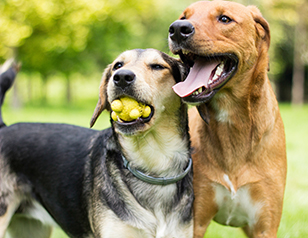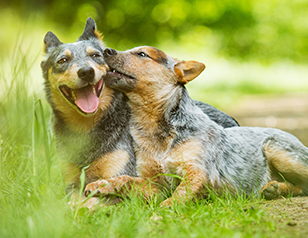Discover 12 Proven Ways to Stop Dogs from Fighting at Home
Living with two dogs that constantly fight can be stressful and even dangerous for dog owners. It’s not uncommon for family dogs to have conflicts, but it’s essential to address and resolve this aggressive behaviour for a harmonious household. This article explores 12 aggressive dog training tips to help you out.
Aggressive Dog Training Tips to Stop Family Dogs from Fighting
1. Separate the Dogs
The first step in managing dog aggression in a multi-dog household is to separate them. This means physically dividing them to prevent further conflicts. Use baby gates, crates, or separate rooms to create a safe space for each dog. This separation will prevent fights and give you time to work on training and behaviour modification without immediate confrontations.
2. Rule Out Illness or Pain
A dog in pain may lash out, so it’s crucial to rule out any medical issues that might be causing discomfort. Consult with your veterinarian to ensure your dogs are healthy and pain-free before proceeding with training.
3. Hire A Force-Free Trainer
Training aggressive dogs is a challenging task and not something you should attempt without professional guidance. Seek the expertise of a force-free dog trainer who specializes in addressing aggressive behaviour. They use positive reinforcement techniques, ensuring a safe and effective approach to training.
4. Provide Ample Resources
Dogs may fight over resources like food, toys, or attention. To prevent such conflicts, ensure each pet has separate food and water bowls, toys, and personal space. This minimizes competition for resources and reduces potential triggers for aggression.
5. Desensitization and Counterconditioning
These are powerful techniques to change your dogs’ emotional responses to each other. With the guidance of a dog trainer for aggressive behaviour, expose your pets to controlled, positive interactions that gradually increase their tolerance of one another. Pair these interactions with rewards, such as treats or playtime, to create positive associations.
6. Learn to Introduce Dogs Properly
Proper introductions between dogs are essential to prevent future conflicts. When introducing two dogs, do it in a controlled environment, with both of them on a leash. Allow them to sniff each other while maintaining a safe distance. Positive associations during initial meetings can help establish a foundation for future coexistence.
7. Learn Dog Body Language
Dogs communicate through body postures and signals, such as wagging tails, raised hackles, and growling. Learning to interpret these cues can help you intervene before a fight and prevent misunderstandings between your dogs.
8. Enforce Your Dogs’ Boundaries
Establishing clear boundaries and rules is essential for maintaining a peaceful household. Consistency in your expectations and enforcing these boundaries through positive reinforcement can help them understand their roles and reduce potential conflicts.
9. Don’t Punish Communication
Dogs communicate through vocalizations and body language. Growling or barking can be their way of saying they’re uncomfortable or anxious. Punishing these warning signs can suppress communication and lead to sudden, unprovoked aggression. Instead of punishing, address the underlying issues causing their distress.
10. Spay and Neuter
Spaying and neutering can play a role in reducing aggression in dogs. While it may not be a guaranteed solution, it can help manage hormonal-driven aggression. Consult your veterinarian about the appropriate timing and potential benefits of spaying or neutering your dogs.
11. Avoid Aversive Methods and Bad Training Advice
Some dog owners resort to aversive methods or outdated aggressive dog training advice, which can exacerbate the behaviour. Avoid practices that involve physical punishment, dominance-based training, or shock collars. These methods can cause fear and aggression and worsen the situation.
12. Consider Medication
In some cases, medication prescribed by a veterinarian may be necessary to manage dog aggression. It can help reduce anxiety or other underlying issues that contribute to aggressive behaviour. Consult with a veterinarian to discuss the potential benefits of medication in your specific situation.
Can Two Dogs Live Together After Fighting?
The answer to this question varies depending on the severity of the aggression, the commitment of the dog owner, and the effectiveness of the training and management techniques employed. While it’s possible for two dogs to live together harmoniously after fighting, it may take time, patience, and professional guidance.
Aggressive Dog Training Can Help!
Is your home filled with tension and fear due to aggressive behaviour in your dogs? It’s time to take action. Aggressive dog training can be the solution you’ve been searching for.
Imagine a life where your dogs coexist peacefully, where your family feels safe, and where your beloved pets thrive. With professional guidance and force-free training techniques, you can make this a reality. Our team of expert dog trainers is here to help you.
Take the first step towards a harmonious home by investing in their training. Reach out to us at 905-830-9500 or toll-free at 1-877-868-7297 today, and let us show you how aggressive dog training can transform your dogs and your life. You can also fill out our online form if you have any questions.
Also Read: A Complete Guide to Training Aggressive Dogs





